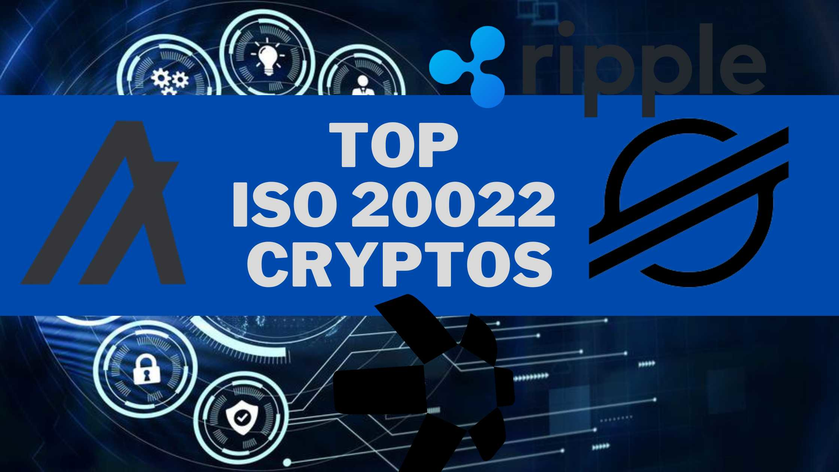New rules and regulations are coming into play and ISO-compliant cryptocurrencies will be the legal and compliant cryptocurrencies when these regulations are announced.
These ISO20022 cryptocurrencies will also form the backbone of the New Financial System, replacing the global SWIFT system. This standard is expected to come into operation in November 2022 and is anticipated to be fully integrated by November 2025.
(Dinarian Note: I disagree 100%, My research has shown me over time that The new system will NOT REPLACE SWIFT... but will indeed work with and assist SWIFT, especially in the arena of cross-border CBDC payments...)
What is ISO 20022?

Top ISO 20022 Compliant Cryptocurrencies
There are officially seven cryptocurrencies that are recognized as ISO20022 compliant:
- Quant (QNT)
- Ripple (XRP)
- Stellar (XLM)
- Hedera (HBAR)
- IOTA (MIOTA)
- XDC Network (XDC)
- Algorand (ALGO)
Quant (QNT)
Quant launched in June 2018, is considered the over-ledger with the goal of connecting (ISO20022) blockchains and networks on a global scale, without reducing the efficiency and interoperability of the network. Quant is slatted as a core component within the deployment of the new ISO20022 financial system.

This is the first project to solve the interoperability problem through the creation of the first blockchain operating system and will be a key component of the interconnectivity of all the ISO20022 crypto projects.
Ripple (XRP)
Launched in 2021, the XRP Ledger (XRPL) is an open-source, permissionless and decentralized technology. Benefits of the XRP Ledger include its low-cost ($0.0002 to transact), speed (settling transactions in 3-5 seconds) and scalability (1,500 transactions per second).
Ripple is a global payments network and also has onboarded many major banks and financial services as its customers. The purpose of XRP is to serve as an intermediate mechanism of exchange between two currencies or networks, acting as a temporary settlement layer denomination.

XRP is a digital currency and acts as a bridge currency to other currencies, primarily for cross-border and international transfers. The XRP Ledger also features the first decentralized exchange (DEX) and custom tokenization capabilities built into the protocol.
Stellar (XLM)
Stellar is a peer-to-peer (P2P) decentralized network created in 2014 by The Stellar Development Foundation. Officially launched in 2015 with the purpose of connecting the world's financial systems (ISO20022) and ensuring a protocol for payment providers and financial institutions.

The platform is designed to move financial resources swiftly and reliably at a minimal cost. Stellar links individuals, banks and payment processors and offers its users the ability to create, send and trade multiple types of crypto.
The basis of the network is its native digital currency - XLM or Lumens. XLM acts as an intermediate currency for operations and is also used to pay transaction fees. The Stellar protocol works by converting the transaction, first into XLM and then into the requested currency.
Hedera (HBAR)
Hedera is the most used, sustainable, enterprise-grade public network for the decentralized economy that allows individuals and businesses to create powerful decentralized applications (DApps).

Hedera Hashgraph’s most unique feature is the mechanism used for grouping transactions called, a hashgraph. It's claimed that this allows the Hedera to process more transactions more cheaply than existing blockchains. The Hashgraph is a patented algorithm and is currently the only cryptocurrency with such a patent.
The Hedera Hashgraph is the first iteration of the algorithm that is used in a public network.
IOTA (MIOTA)
IOTA is a distributed ledger with one big difference: it isn’t actually a blockchain. Instead, its proprietary technology is known as Tangle, a system of nodes that confirm transactions.
Tangle is a proprietary technology, termed a consensus algorithm that requires users to validate two transactions in order to complete their own IOTA transactions. Technically, it is a direct acyclic graph (DAG) consensus algorithm.

With this new form of consensus algorithm, there are no miners or validators, no blocks and no transaction fees. This allows the crypto to “overcome cost and scalability issues of blockchain,” according to the IOTA website.
XDC Network (XDC)
The XDC Network (formerly called XinFin Network) is an enterprise-grade, EVM-compatible, hybrid blockchain, equipped with public and private states and interoperable smart contracts. It was primarily created for multinational business, cross border payments and finance.

A highly optimized, bespoke fork of Ethereum and J.P. Morgan’s (now ConsenSys’s) Quorum, the XDC Network reaches consensus through a delegated proof-of-stake (dPoS) mechanism, which allows for two-second transaction time, near zero gas fees, and over 2,000 transactions per second (TPS).
Algorand (ALGO)
Algorand is considered both a digital currency and blockchain platform. This project has also been labeled the "Ethereum Killer" as it can host other cryptocurrencies and blockchain-based projects, like Ethereum. The Algorand platform is designed to process high-volume transactions quickly, similar to popular payments processors like Mastercard and Visa.

A unique feature of Algorand is that it uses a modified version of the “proof-of-stake” consensus mechanism. While the traditional proof-of-stake method allows cryptocurrency holders to opt into validating transactions, the pure-proof-of-stake method recruits validators from the entire pool of ALGO holders. All ALGO holders who stake their ALGO are rewarded every time a new block is added to the Algorand blockchain.



























